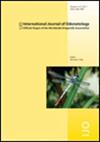COI diversity supports subspecific division in Western European Lestes virens (Charpentier, 1825) (Zygoptera: Lestidae), but hints at further Mediterranean complexity
IF 1
4区 农林科学
Q3 ENTOMOLOGY
引用次数: 0
Abstract
We analyse COI sequences of 48 specimens of European Lestes virens (Charpentier) to explore patterns in genetic diversity including subspecific boundaries and potential glacial refugia. Our haplotype network and phylogenetic analyses reveal three distinct groups in Western and Northern Europe. One group corresponding to the nominate subspecies L. virens virens is confined to the Iberian Peninsula and southwestern France, and one group corresponding to the subspecies L. virens vestalis is found in the rest of western Europe including southern Scandinavia, mainland Italy and the Mediterranean island Sardinia. Surprisingly three specimens from the Mediterranean island Sicily form a highly distinct group in all our analyses. An analysis of molecular variance (AMOVA) confirms that almost all observed genetic variance is explained by variation between these three groups rather than by variation between sample areas or between individuals. We conclude that the subspecific division into L. virens virens and L. virens vestalis is justified, but further studies are needed to determine the status of the populations in Sicily, southeastern Europe, and North Africa. The genetic pattern we find may reflect different glacial refugia: an Iberian/North African refugium for L. virens virens; a potential Italian refugium for L. virens vestalis; and a Sicilian/North African refugium for the Sicilian populations.COI多样性支持西欧Lestes virens的亚种划分(Charpentier,1825)(Zygoptera:Lestidae),但暗示了地中海的进一步复杂性
我们分析了48个欧洲Lestes virens (Charpentier)标本的COI序列,以探索遗传多样性的模式,包括亚特异性边界和潜在的冰川避难所。我们的单倍型网络和系统发育分析揭示了西欧和北欧三个不同的群体。一个与命名亚种L. virens virens相对应的群体局限于伊比利亚半岛和法国西南部,一个与亚种L. virens vestalis相对应的群体存在于西欧的其他地区,包括斯堪的纳维亚半岛南部、意大利大陆和地中海撒丁岛。令人惊讶的是,在我们所有的分析中,来自地中海西西里岛的三个标本形成了一个非常独特的群体。分子变异分析(AMOVA)证实,几乎所有观察到的遗传变异都可以用这三个群体之间的变异来解释,而不是用样本区域之间或个体之间的变异来解释。我们认为,将其亚特异性划分为维伦斯和维斯塔斯是合理的,但需要进一步的研究来确定西西里岛、东南欧和北非地区的种群状况。我们发现的遗传模式可能反映了不同的冰川避难所:伊比利亚/北非避难所为L. virens virens;一个潜在的意大利维伦斯维斯塔斯的避难所;为西西里人建立西西里/北非难民营。
本文章由计算机程序翻译,如有差异,请以英文原文为准。
求助全文
约1分钟内获得全文
求助全文
来源期刊

International Journal of Odonatology
ENTOMOLOGY-
CiteScore
2.30
自引率
0.00%
发文量
15
审稿时长
>12 weeks
期刊介绍:
International Journal of Odonatology (IJO) is aimed at providing a publication outlet for the growing number of students of Odonata. It will address subjects such as the ecology, ethology, physiology, genetics, taxonomy, phylogeny and geographic distribution of species. Reviews will be by invitation, but authors who plan to write a review on a subject of interest to the journal are encouraged to contact the editor.
 求助内容:
求助内容: 应助结果提醒方式:
应助结果提醒方式:


